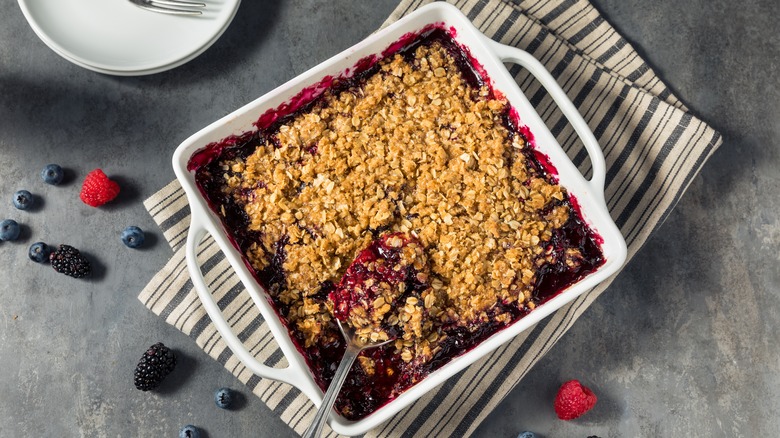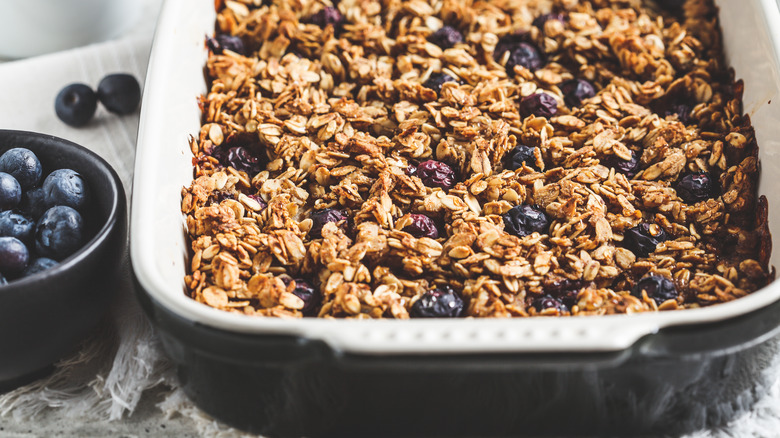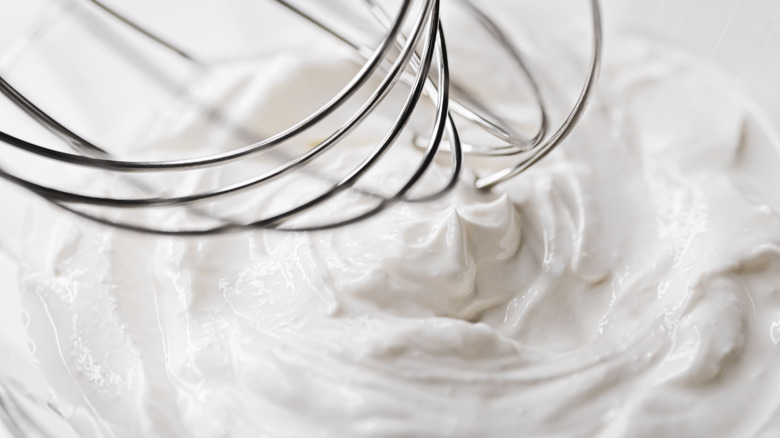Mayo Is The Unexpected Way To Give Blueberry Crisp Some Extra Tang
When you're blessed — or burdened, depending on how you look at it — with more late-summer fruit than you know what to do with, turn to the humble blueberry crisp. It has all the comforting flavors of a pie minus the skill required to roll out a perfectly flaky dough, and, more importantly, plus the delightful crunch of baked oats. Best of all, a crisp gives new purpose to fruit that might be approaching its last leg; the kind that's still edible but is too mushy to eat on its own.
In its most basic form, a crisp is composed of fruit coated in sugar and flour and topped with oats tossed with melted butter (and then more sugar and flour). With such a simple foundation, there's plenty of room to experiment with unlikely ingredients. The next time you make a crisp at home, add a little tang with a dollop of mayonnaise in the oat topping. Though it might seem like a hard sell, trust us: It'll balance out the sweetness of the berries and add some depth of flavor to the dish.
Big Mayonnaise approves of this message
Hellmann's, which is among the top four mayonnaise companies in the world at the time of this writing, will be the first to tell you that fruit crisps and mayo go hand in hand. The brand features a blueberry crisp recipe with mayonnaise on its website, which calls for half a cup of the condiment in the oat topping. (Aside from Hellmann's, Duke's Mayonnaise also calls for mayo in its recipe for apple cobbler, proving that the ingredient pairs well with all kinds of fruity desserts.)
Even people who love sweets know that overripe blueberries need a little acid to take the edge off their sweetness, which is why so many apple pie recipes call for lemon juice. In a crisp, mayonnaise adds just the right amount of zing, thanks to distilled white vinegar and/or lemon juice. While store-bought mayo is totally acceptable, whipping up a homemade version might lead to an even tastier crisp. All you need is an egg, olive oil, lemon juice or vinegar, and salt.
An age-old secret ingredient
Adding mayonnaise to sweets is an older practice than you might think. Some historians trace the origin of mayonnaise cake to the Great Depression, when eggs and other dairy products were hard to come by. Mayonnaise, which was inexpensive and easy to find, added moisture and body to baked goods. The first known published recipe for mayonnaise cake, which appeared in a 1927 issue of the Oakland Tribune, gave rise to the dessert's second wave of popularity during World War II, when baking essentials like sugar, milk, eggs, and butter were rationed.
Today's unpredictable egg prices — which, after months of inflation, are finally going down — might not be dire enough to inspire a mass resurgence of mayonnaise-based baking. Still, it's good to know that the condiment is always there in tough times. Regardless of the state of the economy, however, mayonnaise is definitely worth adding to your next fruit crisp.


